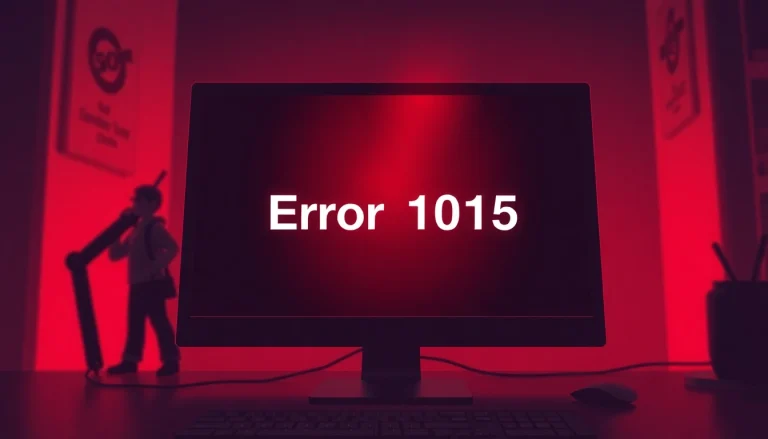What is Error 1015 and Why Does it Occur?
Defining Error 1015: A Brief Overview
Error 1015 is a specific message returned by websites protected by Cloudflare when a user has been temporarily blocked from accessing the site due to rate-limiting policies. This error, represented by the phrase “You are being rate limited,” indicates that the website owner has set restrictions on the number of requests a user can make within a given time frame. This could be implemented for several reasons, including preventing abuse of resources, mitigating DDoS attacks, or simply ensuring fair usage among all website visitors. Understanding this error requires a closer look at the underlying causes and its implications for both users and website owners.
Common Causes of Rate Limiting
Rate limiting is a standard practice utilized by webmasters to protect their sites from various abuses and overload scenarios. Common causes for a user being rate-limited can include:
- Excessive Requests: Rapidly refreshing a page or sending multiple requests can trigger rate-limiting.
- Automated Bots: Bots designed to scrape content or test vulnerabilities can easily hit rate limits.
- Shared IP Addresses: Users on a shared network, such as at universities or offices, can collectively trigger rate limiting.
- Unusual Traffic Patterns: Sudden spikes in traffic to a specific URL can alert Cloudflare’s monitoring systems.
For users accessing sites like https://mmoo.uk.net/, understanding these causes can help manage their access and avoid hitting rate limits.
Implications of Being Rate Limited
Encountering Error 1015 can lead to significant frustration for users, as it directly interrupts their ability to access content. Users may miss critical information or services, impacting their overall experience. For website owners, it signifies a need to balance security with user accessibility. Being overly stringent with rate limits may alienate genuine users, while too lax policies could expose the site to risks. Hence, configuring these limits requires careful consideration of traffic dynamics and user behavior patterns.
How to Identify When You Encounter Error 1015
Key Indicators of Rate Limiting
When you encounter Error 1015, there are some key indicators to both look for and understand:
- Unusual Error Message: The specific wording of the error is a clear sign of a rate-limiting issue.
- Duration of Access Denial: Message may mention a temporary ban, indicating time limitations.
- Context of Access: Consider what you were doing right before the error appeared; rapid clicking or refreshing usually leads to this.
Understanding Your Cloudflare Ray ID
Each time a rate limit is triggered, Cloudflare generates a unique Ray ID that can appear in the error message. This ID is useful for diagnosing issues and may be provided to website administrators when seeking assistance. Users can provide this Ray ID to support teams to help pinpoint the instance when access was denied, potentially leading to faster resolution.
When to Seek Technical Support
If you find that you repeatedly encounter Error 1015 despite reasonable browsing habits, it may signal a deeper underlying issue. Consider contacting technical support if:
- You have confirmed that you are not engaging in behavior typically associated with triggering rate limits.
- The issue persists over extended periods or after typical timeouts.
- You suspect your IP is being misidentified or mistaken for a bot.
Steps to Resolve Error 1015 Access Issues
Temporary Solutions for Users
For users facing Error 1015, there are some temporary solutions to consider:
- Retry After Some Time: Wait for a specified time (usually stated in the error message) before trying to access the site again.
- Clear Your Browser Cache: Sometimes, stored data can interfere with access.
- Use a Different Browser or Incognito Mode: This can bypass cache-related issues or extensions that may be interfering.
- Change Your Internet Connection: Switching to a different network or using a VPN can help, particularly in the case of shared IP addresses.
Long-term Fixes for Website Owners
Website owners can implement several long-term strategies to manage rate limiting effectively:
- Optimize Rate-Limiting Rules: Adjusting the thresholds based on typical user access patterns can help maintain accessibility.
- Monitor Traffic: Use analytics tools to understand traffic trends, identifying when and where limits are triggered most often.
- Implement CAPTCHAs: For high-traffic resources, adding CAPTCHAs can help distinguish legitimate users from bots.
- Improve Server Capacity: Consider enhancing server resources to better handle spikes in traffic without restricting users.
Best Practices for Preventing Rate Limiting
Establishing best practices can significantly reduce the likelihood of rate limiting impacting both users and website operators:
- Educate Users: Inform users about acceptable use policies to prevent accidental triggering of rate limits.
- Use Load Balancers: Distributing traffic across multiple servers can improve robustness against sudden spikes.
- Test Regularly: Regularly testing website conditions during peak traffic times can help find potential weaknesses before they lead to rate limiting.
Analyzing the Impact of Rate Limiting on User Experience
Understanding User Frustration During Accessibility Issues
Understanding the psychological impact that rate limiting can have on users is vital for website owners. Visitors encountering an unexpected access denial often feel confused and frustrated:
- Perceived Inaccessibility: Users may feel the site is unreliable, leading to diminished trust.
- Time Loss: For users seeking immediate information or services, encountering this error can lead to a loss of valuable time.
- Increased Bounce Rates: High rates of encountering Error 1015 often result in users abandoning their attempts to access the site altogether.
Case Studies of Websites Facing Similar Issues
Various high-traffic websites have faced errors resulting from rate limiting. For instance, large news portals or popular online services experience surges in traffic during events. Implementing smart rate-limiting strategies, such as dynamic thresholds, has helped some of these sites maintain user experience without compromising safety or performance. Case studies can be looked up for detailed insights into how different websites managed their rate-limiting challenges.
Strategies to Mitigate User Impact
Creating a positive user experience while dealing with rate limits involves proactive strategies:
- Clear Communication: Notify users when they are about to hit a rate limit, allowing them to adjust their behavior accordingly.
- FAQ Sections: Include information about common access issues and their resolutions to inform users preemptively.
Future of Website Security and Rate Limiting
The Evolving Landscape of Web Security
As internet traffic continues to grow, the techniques utilized to manage security threats are evolving. Future developments in rate limiting and overall security may incorporate artificial intelligence to predict patterns of abuse and establish adaptive rate-limiting protocols. This can promote a more nuanced approach to user access while maintaining a secure environment.
Balancing Security and Accessibility
Striking a balance between bolstering security and ensuring user accessibility is a central concern for many site administrators. The more rigorous the security measures implemented, the greater the risk of alienating users. Effective protocols must prioritize both protecting the site and upholding a positive user experience.
Emerging Trends in Cloudflare and Error Management
Cloudflare is continuously innovating to provide better tools for managing common errors like Error 1015. Future features may include more granular user analytics or automatic adjustments to rate limits based on real-time traffic patterns. Staying informed on these developments can aid both users and website owners in adapting to ongoing changes in the web ecosystem.
Conclusion
Error 1015 signifies a temporary rate-limiting situation that can frustrate users and challenge website owners. However, by understanding the causes, indicators, and resolutions related to this error, both parties can enhance their experiences online. Applying preventative measures, maintaining communication, and preparing for future trends in web security can build a robust framework for managing access while safeguarding resources. To explore more about navigating online resources and communities, you may want to look into THỂ THAO MMOO, where insights and discussions regarding user access and restrictions are ongoing.













